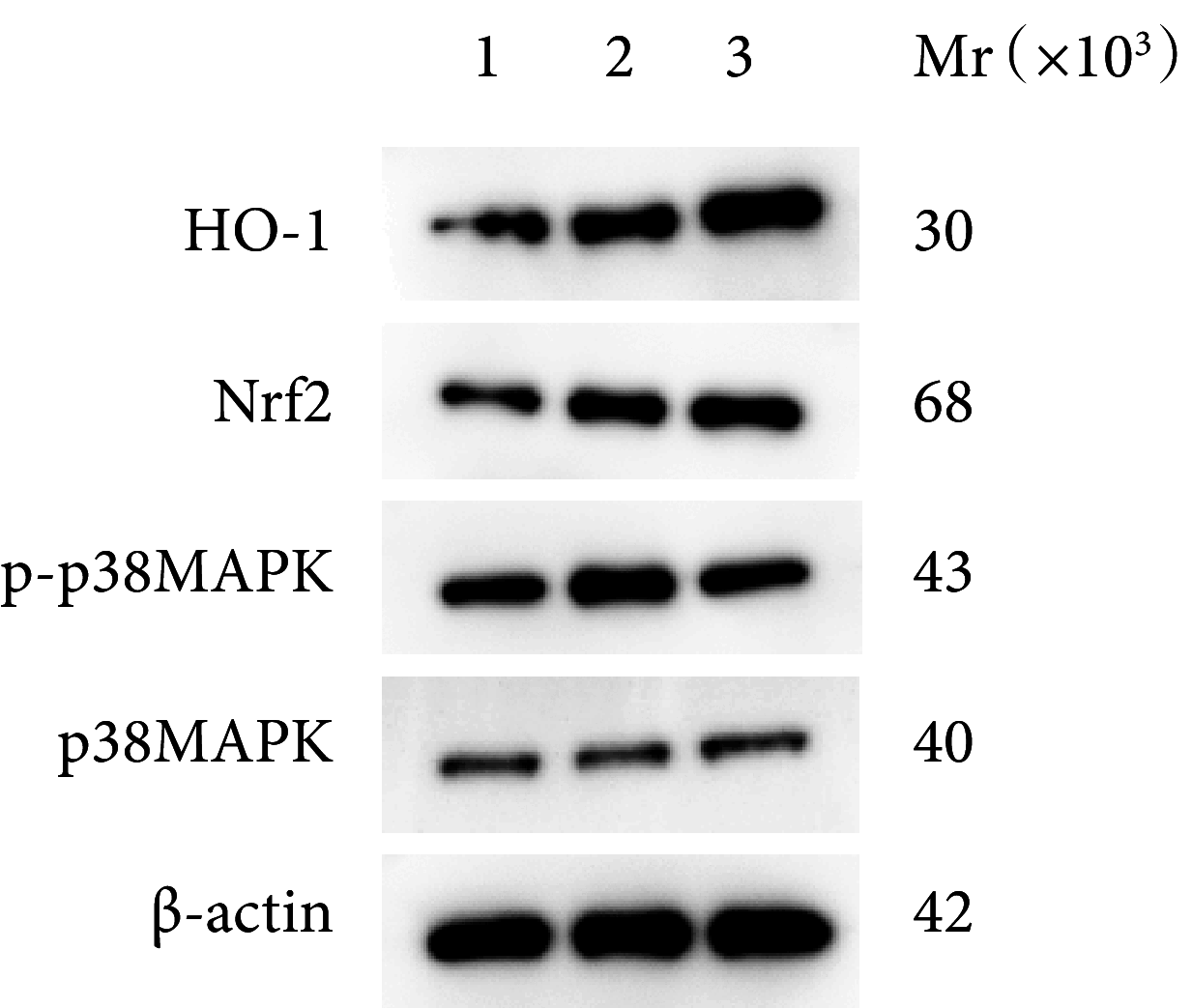[Experimental study on promotion of peripheral nerve regeneration by selenium-methylselenocysteine]
- PMID: 38752248
- PMCID: PMC11096885
- DOI: 10.7507/1002-1892.202402031
[Experimental study on promotion of peripheral nerve regeneration by selenium-methylselenocysteine]
Abstract
Objective: To investigate the feasibility of selenium-methylselenocysteine (SMC) to promote peripheral nerve regeneration and its mechanism of action.
Methods: Rat Schwann cells RSC96 cells were randomly divided into 5 groups, which were group A (without any treatment, control group), group B (adding 100 μmol/L H 2O 2), group C (adding 100 μmol/L H 2O 2+100 μmol/L SMC), group D (adding 100 μmol/L H 2O 2+200 μmol/L SMC), group E (adding 100 μmol/L H 2O 2+400 μmol/L SMC); the effect of SMC on cell proliferation was detected by MTT method, and the level of oxidative stress was detected by immunofluorescence for free radicals [reactive oxygen species (ROS)] after determining the appropriate dose group. Thirty-six 4-week-old male Sprague Dawley rats were randomly divided into 3 groups, namely, the sham operation group (Sham group), the sciatic nerve injury group (PNI group), and the SMC treatment group (SMC group), with 12 rats in each group; the rats in the PNI group were fed with food and water normally after modelling operation, and the rats in the SMC group were added 0.75 mg/kg SMC to the drinking water every day. At 4 weeks after operation, the sciatic nerves of rats in each group were sampled for neuroelectrophysiological detection of highest potential of compound muscle action potential (CMAP). The levels of inflammatory factors [interleukin 17 (IL-17), IL-6, IL-10 and oxidative stress factors catalase (CAT), superoxide dismutase (SOD), and malondialdehyde (MDA)] were detected by ELISA assay. The luxol fast blue (LFB) staining was used to observe the myelin density, fluorescence intensity of glial fibrillary acidic protein (GFAP) and myelin basic protein (MBP) was observed by immunofluorescence staining, and myelin morphology was observed by transmission electron microscopy with measurement of axon diameter. Western blot was used to detect the protein expressions of p38 mitogen-activated protein kinases (p38MAPK), phosphorylated p38MAPK (p-p38MAPK), heme oxygenase 1 (HO-1), and nuclear factor erythroid 2-related factor 2 (Nrf2).
Results: MTT assay showed that the addition of SMC significantly promoted the proliferation of RSC96 cells, and the low concentration could achieve an effective effect, so the treatment method of group C was selected for the subsequent experiments; ROS immunofluorescence test showed that group B showed a significant increase in the intensity of ROS fluorescence compared with that of group A, and group C showed a significant decrease in the intensity of ROS fluorescence compared with that of group B ( P<0.05). Neuroelectrophysiological tests showed that the highest potential of CMAP in SMC group was significantly higher than that in PNI and Sham groups ( P<0.05). ELISA assay showed that the levels of IL-6, IL-17, and MDA in PNI group were significantly higher than those in Sham group, and the levels of IL-10, SOD, and CAT were significantly lower; the levels of IL-6, IL-17, and MDA in SMC group were significantly lower than those in PNI group, and the levels of IL-10, SOD, and CAT were significantly higher ( P<0.05). LFB staining and transmission electron microscopy showed that the myelin density and the diameter of axons in the SMC group were significantly higher than those of the PNI group and the Sham group ( P<0.05). Immunofluorescence staining showed that the fluorescence intensity of GFAP and MBP in the SMC group were significantly stronger than those in the PNI group and Sham group ( P<0.05). Western blot showed that the relative expressions of Nrf2 and HO-1 proteins in the SMC group were significantly higher than those in the PNI group and Sham group, and the ratio of p-p38MAPK/p38MAPK proteins was significantly higher in the PNI group than that in the SMC group and Sham group ( P<0.05).
Conclusion: SMC may inhibit oxidative stress and inflammation after nerve injury by up-regulating the Nrf2/HO-1 pathway, and then inhibit the phosphorylation of p38MAPK pathway to promote the proliferation of Schwann cells, which ultimately promotes the formation of myelin sheaths and accelerates the regeneration of peripheral nerves.
目的: 探讨硒-甲基硒代半胱氨酸(selenium-methylselenocysteine,SMC)促进周围神经再生的可行性及其作用机制。.
方法: 将大鼠雪旺细胞RSC96细胞随机分为5组,分别为A组(无任何处理对照组)、B组(加入100 μmol/L H 2O 2)、C组(加入100 μmol/L H 2O 2+100 μmol/L SMC)、D组(加入100 μmol/L H 2O 2+200 μmol/L SMC)、E组(加入100 μmol/L H 2O 2+400 μmol/L SMC);通过MTT法检测SMC对细胞增殖的影响,确定合适剂量组别后,通过自由基(reactive oxygen species,ROS)免疫荧光检测细胞氧化应激水平。将36只4周龄雄性SD大鼠随机分为3组,分别为假手术组(Sham组)、坐骨神经损伤组(PNI组)及SMC治疗组(SMC组),每组12只;PNI组大鼠造模术后正常喂食、水,SMC组大鼠于每日饮用水中加入0.75 mg/kg SMC。术后4周各组大鼠坐骨神经取材行神经电生理检测复合肌肉动作电位(compound muscle action potential,CMAP)最高电位 ,ELISA法检测炎症因子IL-17、IL-6、IL-10和氧化应激因子过氧化氢酶(catalase,CAT)、超氧化物歧化酶(superoxide dismutase,SOD)、丙二醛(malondialdehyde,MDA)水平,劳克坚劳蓝(luxol fast blue,LFB)染色观测髓鞘密度,免疫荧光染色观察胶质纤维酸性蛋白(glial fibrillary acidic protein,GFAP)和髓鞘碱性蛋白(myelinbasicprotein,MBP)荧光强度,透射电镜观察髓鞘形态并测量轴突直径,Western blot检测p38丝裂原活化蛋白激酶(mitogen-activated protein kinases,MAPK)、磷酸化p38MAPK(phosphorylation p38MAPK,p-p38MAPK)、血红素氧合酶1(heme oxygenase 1,HO-1)、核因子红细胞系2相关因子2(nuclear factor erythroid 2-related factor 2,Nrf2)蛋白相对表达量。.
结果: MTT检测示加入SMC后显著促进RSC96细胞增殖,且低浓度即可达有效效果,故选择C组进入后续实验;ROS免疫荧光检测示B组较A组ROS荧光强度明显上升,C组较B组ROS荧光强度明显下降( P<0.05)。动物实验神经电生理检测示,SMC组CMAP最高电位显著高于PNI组和Sham组( P<0.05)。ELISA检测示,PNI组较Sham组IL-6、IL-17、MDA水平明显上升,IL-10、SOD、CAT水平明显下降;SMC组较PNI组IL-6、IL-17、MDA水平明显下降,IL-10、SOD、CAT水平明显上升( P<0.05)。LFB染色和透射电镜检测示SMC组的髓鞘密度和轴突直径明显优于PNI组和Sham组( P<0.05)。免疫荧光染色示SMC组GFAP和MBP荧光强度显著强于PNI组和Sham组( P<0.05)。Western blot检测示SMC组Nrf2、HO-1蛋白相对表达量显著高于PNI组和Sham组,PNI组p-p38MAPK/p38MAPK蛋白表达量比值显著高于SMC组和Sham组( P<0.05)。.
结论: SMC可能通过上调Nrf2/HO-1通路抑制神经损伤后的氧化应激和炎症反应,进而抑制p38MAPK通路磷酸化促进雪旺细胞增殖,最终促进髓鞘形成和加速周围神经再生。.
Keywords: Nerve regeneration; inflammatory response; oxidative stress; p38 mitogen-activated protein kinase pathway; selenium-methylselenocysteine.
Conflict of interest statement
利益冲突 在课题研究和文章撰写过程中不存在利益冲突;经费支持没有影响文章观点和对研究数据客观结果的统计分析及其报道
Figures






Similar articles
-
Sustainable Release Selenium Laden with SiO2 Restoring Peripheral Nerve Injury via Modulating PI3K/AKT Pathway Signaling Pathway.Int J Nanomedicine. 2024 Aug 1;19:7851-7870. doi: 10.2147/IJN.S460397. eCollection 2024. Int J Nanomedicine. 2024. PMID: 39105098 Free PMC article.
-
[Role and mechanism of SIRT1 in regulating Nrf2/HO-1 signaling pathway in septic liver injury].Zhonghua Wei Zhong Bing Ji Jiu Yi Xue. 2023 Jun;35(6):598-603. doi: 10.3760/cma.j.cn121430-20220815-00744. Zhonghua Wei Zhong Bing Ji Jiu Yi Xue. 2023. PMID: 37366125 Chinese.
-
Ulinastatin Promotes Regeneration of Peripheral Nerves After Sciatic Nerve Injury by Targeting let-7 microRNAs and Enhancing NGF Expression.Drug Des Devel Ther. 2020 Jul 9;14:2695-2705. doi: 10.2147/DDDT.S255158. eCollection 2020. Drug Des Devel Ther. 2020. PMID: 32753848 Free PMC article.
-
Therapeutic effect of exosomes derived from Schwann cells in the repair of peripheral nerve injury.Life Sci. 2024 Nov 15;357:123086. doi: 10.1016/j.lfs.2024.123086. Epub 2024 Sep 30. Life Sci. 2024. PMID: 39357794 Review.
-
Unraveling the immune system's role in peripheral nerve regeneration: a pathway to enhanced healing.Front Immunol. 2025 Feb 21;16:1540199. doi: 10.3389/fimmu.2025.1540199. eCollection 2025. Front Immunol. 2025. PMID: 40061948 Free PMC article. Review.
References
-
- 黄喜军, 朱庆棠, 江丽, 等 去细胞异种神经复合同种异体脂肪干细胞修复猕猴周围神经缺损的免疫反应研究. 中国修复重建外科杂志. 2012;26(8):993–1000.
Publication types
MeSH terms
Substances
LinkOut - more resources
Full Text Sources
Miscellaneous
